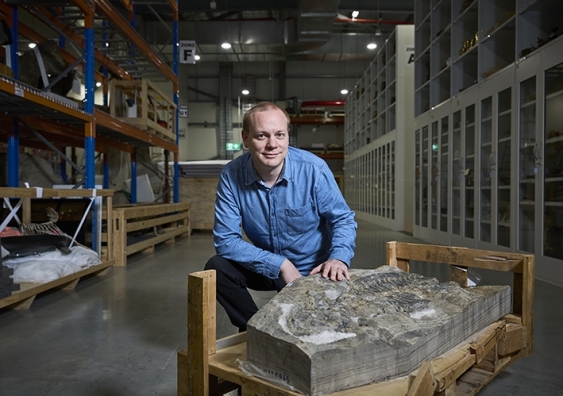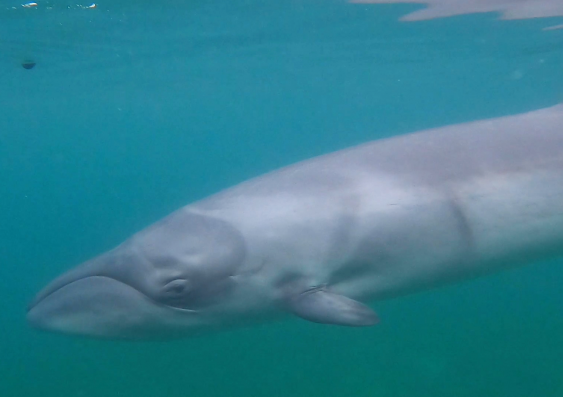Australian scientists discover ancient freshwater fish fossil with preserved stomach contents
2025-03-18T08:12:00+11:00

┬® Salty Dingo 2020 CG
Palaeontologists have unearthed a 15-million-year-old fish fossil that offers unique insights into ancient ecosystems.
A team of scientists led by Australian Museum and ▓¦¦«╩ËãÁ Sydney palaeontologist Dr Matthew McCurry have described a new species of 15-million-year-old fossilised freshwater fish, Ferruaspis brocksi, that preserves stomach contents as well as the pattern of colouration. The research is published today in .╠²
Named after Professor Jochen J. Brocks from the Australian National University, who discovered several of the fossilised species at the near Gulgong, NSW, Ferruaspis brocksi is the first fossil freshwater smelt (order Osmeriformes) to be found in Australia.
Dr McCurry, the lead author of the paper, said before this fossil discovery scientists had lacked concrete evidence to pinpoint when this group of fish arrived in Australia and how they evolved over time.
ÔÇ£The discovery of the 15-million-year-old freshwater fish fossil offers us an unprecedented opportunity to understand AustraliaÔÇÖs ancient ecosystems and the evolution of its fish species, specifically the Osmeriformes group during the Miocene epoch,ÔÇØ said Dr McCurry, who is a Conjoint Lecturer at ▓¦¦«╩ËãÁÔÇÖs Earth & Sustainability Science Research Centre.
ÔÇ£Osmeriformes are a diverse group of fish within Australia which includes species like the Australian Grayling and the Australian Smelt. But, without fossils it has been hard for us to tell exactly when the group arrived in Australia and whether they changed at all through time,ÔÇØ Dr McCurry said.
ÔÇ£Not only does this fossil provide a unique snapshot into the environment it lived, but also, because its stomach contents are so well preserved, it allows us a glimpse into the behaviour of these ancient species. We now know that they fed on a range of invertebrates, but the most common prey was small phantom midge larvae,ÔÇØ Dr McCurry said.
ÔÇ£One of the fossils even shows a parasite attached to the tail of the fish. ItÔÇÖs a juvenile freshwater mussel╠²called a glochidium. These juvenile mussels╠²attach themselves to the gills or tails of fish to hitch rides up and down streams.ÔÇØ
Media enquiries
Isabelle Dubach, Senior News & Content Manager
Tel:╠²+61 432 307 244
Email:╠²i.dubach@unsw.edu.au
The species was named Ferruaspis brocksi because it was found encased in iron-rich rock. ÔÇ£Ferru,ÔÇØ from ferrum (Latin), meaning ÔÇ£ironÔÇØ, and ÔÇ£brocksiÔÇØ, after Professor Jochen J. Brocks of Canberra, Australia.╠²╠²╠²╠²╠²╠²╠²╠²╠²╠²╠²╠²╠²╠²╠²╠²╠²╠²╠²╠²╠²╠²╠²╠²╠²╠²╠²╠²╠²╠²╠²╠²╠²╠²╠²
Acknowledging this honour, Professor Brocks said he was thrilled to have this superb specimen named after him.╠² ╠² ╠²╠²
ÔÇ£Collecting fossils at McGrath Flat is a highlight for me every year. Splitting the rust-red slabs of rock is like opening an ancient book, revealing the creatures that inhabited an Australian oxbow lake some 15 million years ago. This little fish is one of the most beautiful fossils there, and finding the first vertebrate among the abundant plant and insect fossils was a real surprise. Having╠²F. brocksi╠²named after me is a real joy,ÔÇØ Professor Brocks said.
Dr Michael Frese, a researcher from the University of Canberra and CSIRO, AustraliaÔÇÖs national science agency, said that one of the most exciting aspects of the work was that they could tell the colour of the fish.
ÔÇ£The fish was darker on its dorsal surface, lighter in colour on its belly and had two lateral stripes running along its side,ÔÇØ Dr Frese said.
ÔÇ£Using a powerful microscope, we were able to see tiny colour-producing structures known as melanosomes. Fossilised melanosomes have previously enabled palaeontologists to reconstruct the colour of feathers, but melanosomes have never been used to reconstruction of the colour pattern of a long extinct fish species,ÔÇØ Dr Frese said.
The new fossil site, McGraths Flat, is located in the Central Tablelands, NSW near the town of Gulgong. It represents one of only a handful of fossil sites in Australia that can be classified as a ÔÇÿ╠²ÔÇô a site that contains fossils of exceptional quality with remarkable detail.
ÔÇ£The fossils formed between 11 and 16 million years ago and provide a window into the past. They prove that the area was once a temperate wet rainforest and that life was rich and abundant in the Central Tablelands, NSW,ÔÇØ Dr McCurry said.
The initial McGraths Flat expedition in 2017 was funded through a generous donation from a descendant of Robert Etheridge, an English palaeontologist who came to Australia in 1866. Etheridge joined the fledging Australian Museum in 1887 as assistant palaeontologist and in 1895 was made curator of the museum. Under Etheridge the AMÔÇÖs collections were greatly enhanced and he also launched a programme of expeditions ÔÇô the first being to Lord Howe Island ÔÇô which continues to this day.





